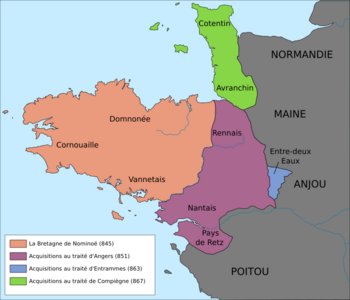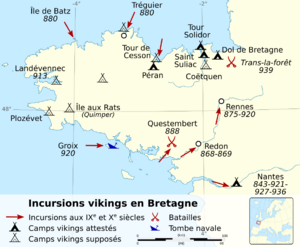Kingdom of Brittany facts for kids
Quick facts for kids
Kingdom of Brittany
|
|||||||||||||||||||||
|---|---|---|---|---|---|---|---|---|---|---|---|---|---|---|---|---|---|---|---|---|---|
| 851–939 | |||||||||||||||||||||

The growth of the Kingdom of Brittany 845–67
|
|||||||||||||||||||||
| Common languages | Breton, Gallo, Latin, French, Norman, Poitevin | ||||||||||||||||||||
| Duke of Brittany | |||||||||||||||||||||
| History | |||||||||||||||||||||
| 22 August 851 | |||||||||||||||||||||
|
• Battle of Trans-la-Forêt
|
1 August 939 | ||||||||||||||||||||
|
|||||||||||||||||||||
The Kingdom of Brittany (Breton: Rouantelezh Breizh) was a kingdom that was connected to the powerful Frankish Empire. It appeared during the time of the Viking invasions. Its story began in 851 when Erispoe claimed the title of king. In 856, Erispoe died, and his cousin Salomon became the next ruler.
The kingdom then faced a difficult period. This was caused by Viking attacks and arguments over who should rule next. These arguments were between Gurvand and Pascweten. Alan, also known as Alan the Great, was Pascweten's brother. He became the third and last person to be called King of Brittany. After Alan the Great died, Vikings took control of Brittany.
In 939, Alan Twistedbeard, who was Alan the Great's grandson, took Brittany back. After this, Brittany became an independent duchy. It stayed this way until it joined France in 1532.
The History of Brittany's Kingdom
Early Beginnings in Brittany
In 383, a Roman soldier named Magnus Maximus was declared emperor in Britain. He then moved his army into Gaul (modern-day France). He ordered some of his soldiers to settle in the western part of the Armorican peninsula. They were to remove any soldiers loyal to the old emperor.
Later, between the 5th and 7th centuries, more Celtic people from Britain arrived. They were escaping the Anglo-Saxon settlement of Britain in their homeland. These new settlers moved into the same region. Because of them, the area was eventually renamed Brittany, meaning "little Britain."
These settlements helped bring back Celtic culture to Armorica. This led to the creation of small, independent kingdoms. These included Cornouaille, Domnonée, and Broërec.
Brittany and the Frankish Empire
From 801 to 837, the nearby Frankish Empire tried many times to control the Breton tribes. But they were not successful. To bring Brittany closer to the Empire, Emperor Louis the Pious chose Nominoe. Nominoe was a Breton noble. Louis made him the leader of the region. Nominoe was called missus imperatoris, which means "Imperial emissary." He was in charge of managing the region for the Emperor.
The Rise of the Kingdom of Brittany

The Battle of Ballon
After Emperor Louis the Pious died, the Viking attacks caused problems for the Frankish Empire. Nominoe took advantage of this situation. He defeated the Frankish troops at the Battle of Ballon in 845. The peace agreement that followed allowed Nominoe to gain more independence from Charles the Bald. Charles was one of Louis the Pious's sons. In 850, the Bretons briefly took over the Frankish Breton March. But after Nominoe died unexpectedly, they went back to their own lands.
The Battle of Jengland and Brittany's First King
Charles the Bald wanted revenge. He invaded Brittany with a large army. Erispoe, Nominoe's son, met Charles's army at the Battle of Jengland in 851. The Bretons won a major victory against the Franks. This made Brittany truly independent from the Frankish Empire. Erispoe became the first king of Brittany.
Later that year, the Treaty of Angers was signed. This treaty added the Pays de Retz region to Erispoe's kingdom. In 856, the Kingdom of Brittany and the Frankish Empire joined forces. They wanted to fight against the Viking invasions. However, Erispoe died that same year. His cousin Salomon took the throne. Salomon then allied with the Vikings to capture the Frankish city of Le Mans.
Brittany's Second King
Charles the Bald made peace with the Bretons by giving them land. He gave them the provinces of Cotentin in 863 and Maine in 867. In 874, Salomon was killed in a plot. Pascweten and Gurvand were involved in this plot. A civil war then started between Pascweten and Gurvand. Both of them died in 876. But the war continued between their successors. These were Alan (Pascweten's brother) and Judicael (Gurvand's son).
Brittany's Third King
Alan and Judicael made a temporary peace. They allied to fight against Viking attacks. In 888, during one of these attacks in Questembert, Judicael died. Alan then became the king of Brittany, known as Alan I.
The End of the Kingdom
Alan I died in 907. After some disagreement about who should rule, Gourmaëlon took over. But he did not claim the title of king. Not much is known about his time as ruler. This is because Viking raids increased a lot, making the region even more unstable. Gourmaëlon likely died during one of these attacks in 913.
The Viking Occupation
From 919, Vikings completely took over Brittany. Monasteries and cities were looted. Many Bretons had to flee to other countries.
Brittany's Reconquest
In 935, Alan Twistedbeard returned to Brittany. He was Alan I's grandson. He had fled to England after an earlier attempt to fight the Vikings failed. Now, he came back to take his land. By 937, he had won back most of Brittany. The Vikings retreated to their stronghold at Trans-la-Forêt. In 939, a combined army of Frankish and Breton soldiers attacked the fortress. They defeated the Viking threat in Brittany.
Becoming a Duchy
Brittany was in ruins after many years of occupation and war. Alan Twistedbeard could not bring back the kingship of Brittany. So, in 942, he paid tribute to King Louis IV of France. He became the Duke of Brittany instead of a king.
Important Rulers of Brittany
Here are some of the key leaders who ruled Brittany before and during the kingdom period:
- Judicael (around 590–657): He was a high king of Brittany and king of Domnonée. He united the Breton kingdoms of Domnonée and Broërec.
- Morman (ruled 814–818): He was the first ruler called King of Brittany by the Breton nobles after Charlemagne died in 814. Morman had served Charlemagne. He rebelled against Frankish rule but was defeated by Louis the Pious.
- Wihomarc (ruled 822–825): He led a successful rebellion to bring back Breton rule. He was killed by Lambert I, the Count of Nantes.
- Nominoe (or Nevenoe) (ruled 841–851): He was a count of Vannes and the first duke of Brittany. He is traditionally known as the Father of the Country.
- Erispoe (ruled 851–857): He was a Count of Vannes and Nominoe's son. He ruled as a duke, then as king. He died, and his cousin Salomon took over.
- Salomon (or Salaun) (ruled 857–874): He was a count of Rennes and Nantes. He led a revolt against Erispoe. He ruled as a duke, then as king. He was the last ruler of a united Brittany until Alan I. Salomon was killed in a revolt. He was later recognized as a saint.
- Period of divided rule (874–888): Brittany was split during a civil war and the first Viking invasion.
- Southern Brittany was ruled by Pascweten (ruled 874–877), a count of Vannes. Then by Alan the Great (ruled 877–888), Pascweten's brother.
- Northern Brittany was ruled by Gurvand (ruled 874–877). Then by Judicael (ruled 877–888), Gurvand's son.
- Alan I, or Alan the Great (ruled 888–907): He first ruled with Judicael. After Judicael's death, he ruled alone as a duke. He was given the title of king by Emperor Charles the Fat. He was the last king of Brittany.
- Second Viking invasion and occupation (907–937): During this time, Alan I's grandson, Alan II, lived in exile in England.

